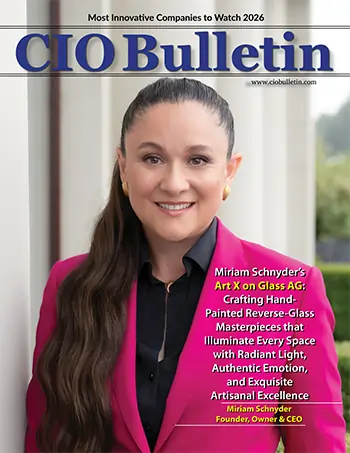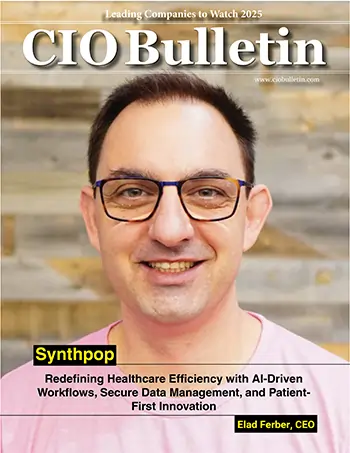50 Most Innovative Companies to Watch 2021
CIO Bulletin

FEops is a digital health player offering cloud-based procedure planning solutions in the structural heart space. The firm combines Digital Twin (virtual copies of the heart) and AI technologies to revolutionize structural heart planning. FEops HEARTguide is a one-in-its-kind procedure planning platform for structural heart interventions that provides physicians with unique insights to evaluate device sizing and positioning pre-operatively.
To highlight and further understand what FEops stands for and seeks to explore in this segment, I sat down with Matthieu De Beule, who serves as the company’s Chief Executive Officer.
Below is an excerpt
Q. How is your company working on bettering patient care?
FEops is developing digital twin technology for the structural heart space, creating a unique environment for procedure planning of structural heart interventions. We can pre-operatively make a dedicated digital twin or a personalised computer model of a patient and can assess different treatment scenarios. This technology helps physicians optimally prepare and make the right decisions regarding the correct implant size, position, and fit for a particular patient. In future, our digital twin technology can also be combined with fusion technologies and used in the catheterization laboratory or in the operating theater to help physicians, surgeons or even robots easily navigate the device to the optimal position they have selected pre-operatively.
Q. What can you tell us about your innovative platform, FEops HEARTguide? How does it support physicians in improving patient outcomes, especially for patients with structural heart disease?
FEops HEARTguide is the only technology in the world that is clinically available in the field of structural heart, which combines digital twin and AI technology. We make functional use of medical images to study in detail how the device will interact with the anatomy and how both the device and the anatomy will be deformed. This analysis gives physicians unprecedented insights into how a specific implant will interact with a particular patient, and vice versa. For example, when there is sub-optimal implantation during TAVR or TAVI (a minimally invasive procedure where a new valve is inserted without removing the old, diseased aortic valve), risk of paravalvular leakage, or any conduction abnormalities exist, and FEops HEARTguide helps to assess and reduce such risks.
When it comes to the mitral valve replacement space, our technology will help physicians to accurately assess the risk of LVOT obstruction, a life threatening complication. Also in left atrial appendage occlusion (LAAo), FEops has shown his value. Given the large anatomical variability of the left atrial appendage, physicians tend to use on average 1.4 devices per patient. Whereas, with FEops HEARTguide, we have preliminary data that this can be brought down to one device per patient as it analyzes the patient more in detail upfront and helps physicians select the suitable device for that patient. It provides clinicians and medical device manufacturers first-ever insights into the interaction between transcatheter structural heart devices and specific patient anatomy, pre-operatively.
Q. Personalized medicine/treatment is the new buzzword given how the pandemic has impacted our circumstances? So, how is your company revolutionizing personalized treatment with regard to structural heart disease?
As mentioned earlier, we are revolutionizing structural heart interventions by making our digital twin and AI technology available and providing unique insights to the physicians and the product specialists of the device manufacturing companies. With our cloud-based approach you can centralize all the data and, of course, create a very interesting data lake where you can do data analytics and get actionable insights.
And next to that, with the annotated database of all these patients, we can develop targeted AI models that can automatically help us in determining the anatomical measurements, which currently are mostly still done manually. So the process will be more accurate, consistent, and faster. Also, once you have such a database of validated digital twins, it becomes a potent tool for designing next generation devices. We’re doing this already, with all leading device manufacturers worldwide; we help them create next-gen products in an extremely time-and cost-efficient manner.
Q. Is simulation-based pre-operative planning the future for treating heart-related diseases?
Yes. There’s absolutely no doubt in my mind that this digital twin technology is one of the new frontiers in cardiovascular disease management. If you look at the current planning software tools, they allow to analyse the anatomy manually. But you have limited information on how the device will interact with that particular patient. Also, it would of course be better if you could have a greater level of understanding regarding the risk of potential complications. With that said, I am sure that this will become the standard for every patient in the structural heart space in a couple of years. It will enable you to understand preoperative procedures easily. It will impact the procedure efficiency as it will reduce the procedure time and complication rate.
Q. FEops leads the way, charting new territories in this segment. So what does the company strive to achieve next?
Well, our company currently has a very strong focus on structural heart interventions. And if you look at how we have grown the business initially, we have developed these digital twins so that we can predict how the device interacts with the anatomy. Then we created a database of patients, which we are now using with AI to perform the required anatomical measurements in an automated way.
In the coming years, our focus will be on improving peri-procedural guidance. But we take one step at a time. The first step is to make sure we have a significant footprint in the structural heart pre-operative planning market. That’s on a technology development level. We provide information to the physicians as additional information source, and then they decide on implant size and position. Down the road, when robotics will come into the structural heart space, our technology could be a key driver there as well because somebody will need to guide these robots on where to optimally position the device. And our technology is very suitable for that.
Moreover, our technology is pretty unique. It is the only technology worldwide that combines the digital twin and AI approach in the structural heart space and is commercially available in Europe. The good news is that we have recently got approval to use our FEops HEARTguide in the US for our LAAo workflow, and we are excited that we will be the maiden company to bring this unique technology for the first time to the US.
Matthieu De Beule | Co-Founder & CEO
Matthieu De Beule is the co-founder and Chief Executive Officer of FEops. Under his leadership, FEops has transformed from a small academic spin-off into a fast-growing venture capital-backed gazelle in the MedTech sector. He completed his degree in engineering at the University of Ghent in 2002 and earned his Ph.D. in 2008 for his research on cardiovascular device and procedure modeling.







